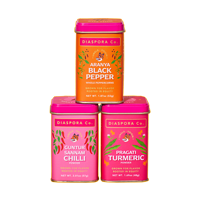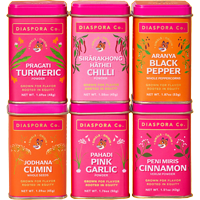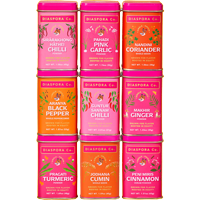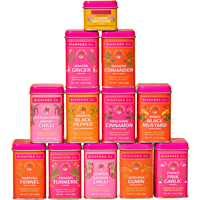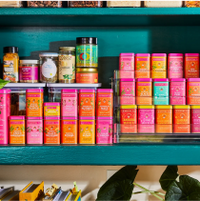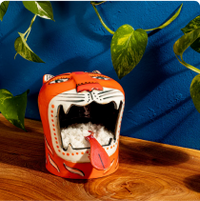
“Blended in each spoonful of Madras curry powder is a larger story of the violence of colonialism, as well as the ways cooks have transformed the homogenized blend into something innovative and exciting.”
– Julia Fine, “From Delhi to Durban: The Many Homes of Madras Curry Powder”
“Curry” powder has long been one of the most controversial spice blends. This seasoning, often labeled “Madras Curry Powder”—Madras, now Chennai, was one of the major trading outposts for the East India Company—in the spice aisle, isn’t actually South Asian at all. It’s a product of—you guessed it!—British colonialism, whose original intent was the domination of the spice trade. As the arms of colonialism spread, the British sought to reduce the breadth of South Asia’s cuisine into one powder, and so “curry”—said to be derived from the words kari in Tamil and karil in Kannada and Malayalam—became the imperialist catch-all for a symphony of regional dishes whose only major common thread was their sauciness.
The paths traveled by “curry” powder are long and many with versions making their way to Trinidad, Guyana, America and beyond. If you haven’t read Julia Fine’s Whetstone South Asia article “From Delhi to Durban: The Many Homes of Madras Curry Powder,” it’s an essential, deeper dive into this blend (there’s only so much space we have in one headnote, after all). And, luckily, over the past few decades, there's been a growing number of chefs, food writers, and companies—oh, hi!—who are highlighting regional South Asian cooking, unweaving the ties of colonialism, and focusing on spices and blends that are specific to states, cities, and even farms (like The Diaspora Co Cookbook—comin’ at ya in Spring 2026!).
Even with its complicated history, “curry” powder is still one of the most highly requested blends in our inbox. So, understanding its roots, we set out to take back “curry” powder and create a DIY version that’s a 1:1 replacement for the dusty store-bought stuff. At its core, this masala is a balance of sweet, fragrant, and warming flavors, with very little heat (though you can dial up the fire if you’d like!). Our take is built with 12 spices, starting with a bright, earthy base of coriander, cumin, and Pragati Turmeric—the latter giving the mix its signature sunny hue—layered with fenugreek seeds, fennel, black pepper, ginger, cloves, and cardamom for plenty of aromatic warmth. Cinnamon and Byadgi chillies bring just a touch of sweetness and gentle kick, while Pahadi Pink Garlic rounds everything out with a whisper of allium flavor.
Honestly, the blend we landed on is pretty damn craveable. I found myself reaching for it time and time again in the weeks after developing the recipe. For me, “curry” powder is a nostalgic taste—a result of growing up in the late 1980s and 90s when the seasoning was having its heyday alongside ranch and sun-dried tomatoes. No, it’s not the blend I use when I want to make an actual regional South Asian dish, but I love it in quick marinades, mixed into mayo, dusted over chicken or vegetables before roasting, and stirred into egg salad, just to name a few.

"Curry" Powder
“Blended in each spoonful of Madras curry powder is a larger story of the violence of colonialism, as well as the ways cooks have transformed the homogenized blend into something innovative and exciting.”
– Julia Fine, “From Delhi to Durban: The Many Homes of Madras Curry Powder”
“Curry” powder has long been one of the most controversial spice blends. This seasoning, often labeled “Madras Curry Powder”—Madras, now Chennai, was one of the major trading outposts for the East India Company—in the spice aisle, isn’t actually South Asian at all. It’s a product of—you guessed it!—British colonialism, whose original intent was the domination of the spice trade. As the arms of colonialism spread, the British sought to reduce the breadth of South Asia’s cuisine into one powder, and so “curry”—said to be derived from the words kari in Tamil and karil in Kannada and Malayalam—became the imperialist catch-all for a symphony of regional dishes whose only major common thread was their sauciness.
The paths traveled by “curry” powder are long and many with versions making their way to Trinidad, Guyana, America and beyond. If you haven’t read Julia Fine’s Whetstone South Asia article “From Delhi to Durban: The Many Homes of Madras Curry Powder,” it’s an essential, deeper dive into this blend (there’s only so much space we have in one headnote, after all). And, luckily, over the past few decades, there's been a growing number of chefs, food writers, and companies—oh, hi!—who are highlighting regional South Asian cooking, unweaving the ties of colonialism, and focusing on spices and blends that are specific to states, cities, and even farms (like The Diaspora Co Cookbook—comin’ at ya in Spring 2026!).
Even with its complicated history, “curry” powder is still one of the most highly requested blends in our inbox. So, understanding its roots, we set out to take back “curry” powder and create a DIY version that’s a 1:1 replacement for the dusty store-bought stuff. At its core, this masala is a balance of sweet, fragrant, and warming flavors, with very little heat (though you can dial up the fire if you’d like!). Our take is built with 12 spices, starting with a bright, earthy base of coriander, cumin, and Pragati Turmeric—the latter giving the mix its signature sunny hue—layered with fenugreek seeds, fennel, black pepper, ginger, cloves, and cardamom for plenty of aromatic warmth. Cinnamon and Byadgi chillies bring just a touch of sweetness and gentle kick, while Pahadi Pink Garlic rounds everything out with a whisper of allium flavor.
Honestly, the blend we landed on is pretty damn craveable. I found myself reaching for it time and time again in the weeks after developing the recipe. For me, “curry” powder is a nostalgic taste—a result of growing up in the late 1980s and 90s when the seasoning was having its heyday alongside ranch and sun-dried tomatoes. No, it’s not the blend I use when I want to make an actual regional South Asian dish, but I love it in quick marinades, mixed into mayo, dusted over chicken or vegetables before roasting, and stirred into egg salad, just to name a few.
Ingredients
- 3 tablespoons (11g) Nandini Coriander seeds
- 1 tablespoon, plus 1¾ teaspoons (10g) Jodhana Cumin seeds
- 2 teaspoons (6g) Hariyali Fennel seeds
- 2½ teaspoons (10g) Sugandhi Fenugreek seeds
- 1 teaspoon (3g) whole Aranya Black Pepper
- 6 Baraka Green Cardamom pods
- 6 whole Kanyan Cloves
- 1½-inch piece (1½g) Wild Cinnamon Quill or 1 teaspoon (2g) Peni Miris Cinnamon
- 3 tablespoons (15g) Pragati Turmeric
- 1½ teaspoons (4g) Byadgi Chilli powder
- 1 teaspoon (1½g) Basiya Ginger powder
- 1 teaspoon (3½g) Pahadi Pink Garlic powder
Methods
- Heat a small skillet over medium-low heat. Add the coriander, cumin, fennel, black pepper, fenugreek seeds, black pepper, cloves, cardamom, and cinnamon quill, if using, broken in pieces (if you’re using ground cinnamon, save it to add later), and toast, stirring frequently, until fragrant and the seeds turn a couple shades darker, 2 to 4 minutes (if the spices start toasting too fast, reduce the heat to low). Transfer to a bowl and let cool completely.
- Transfer the cooled toasted spices to a spice grinder and grind into a fine powder. Scrape down the sides of the grinder, add the turmeric, Byadgi chilli powder, ginger, and garlic powder (if you’re using ground cinnamon, now is the time to add it), and grind for 5 to 10 seconds to combine. Transfer to a jar, seal, and store in a cool, dry place for up to 6 months.




